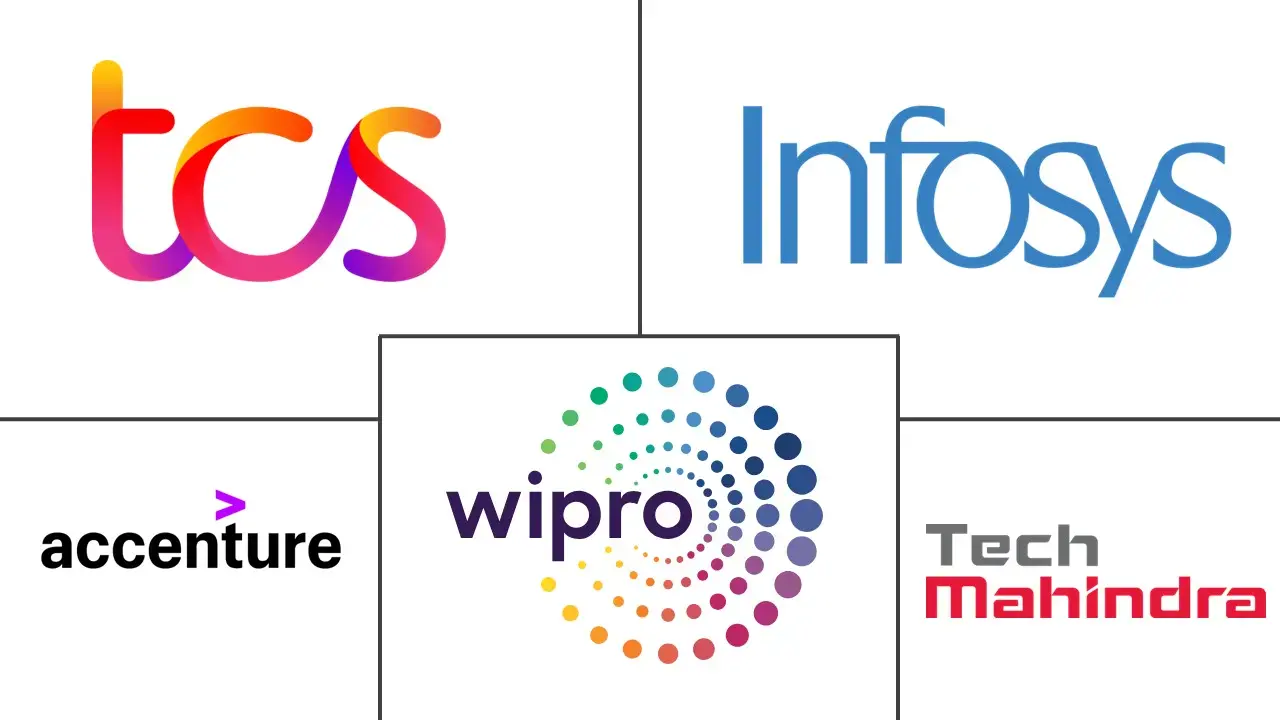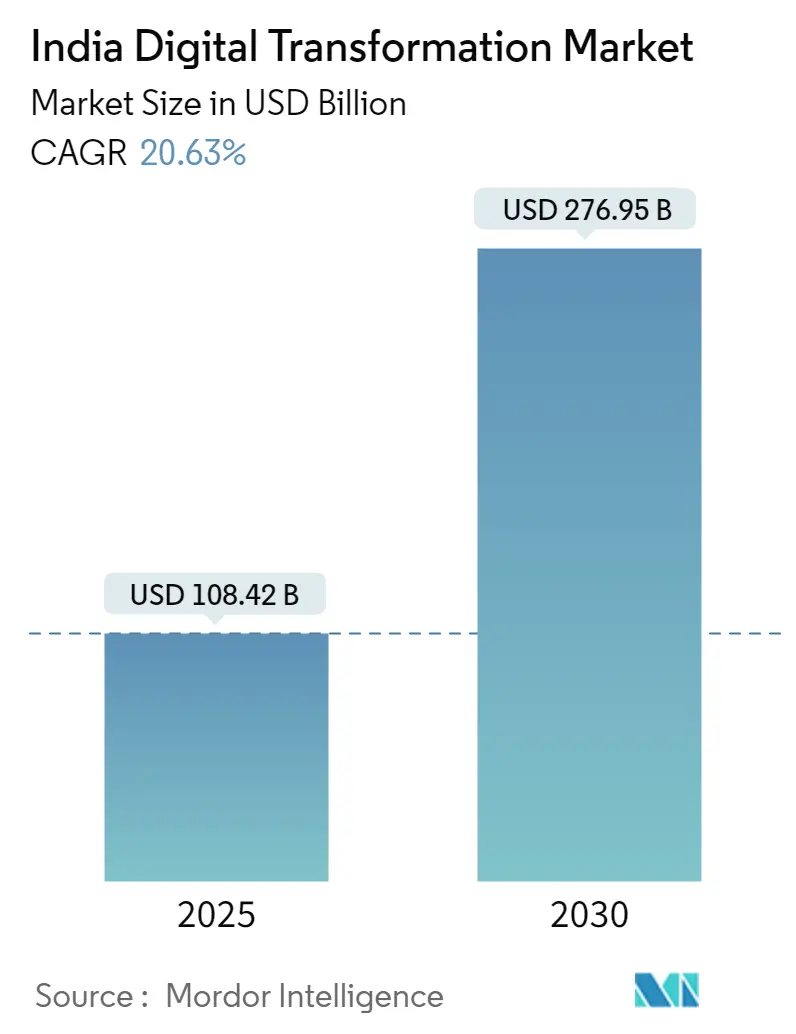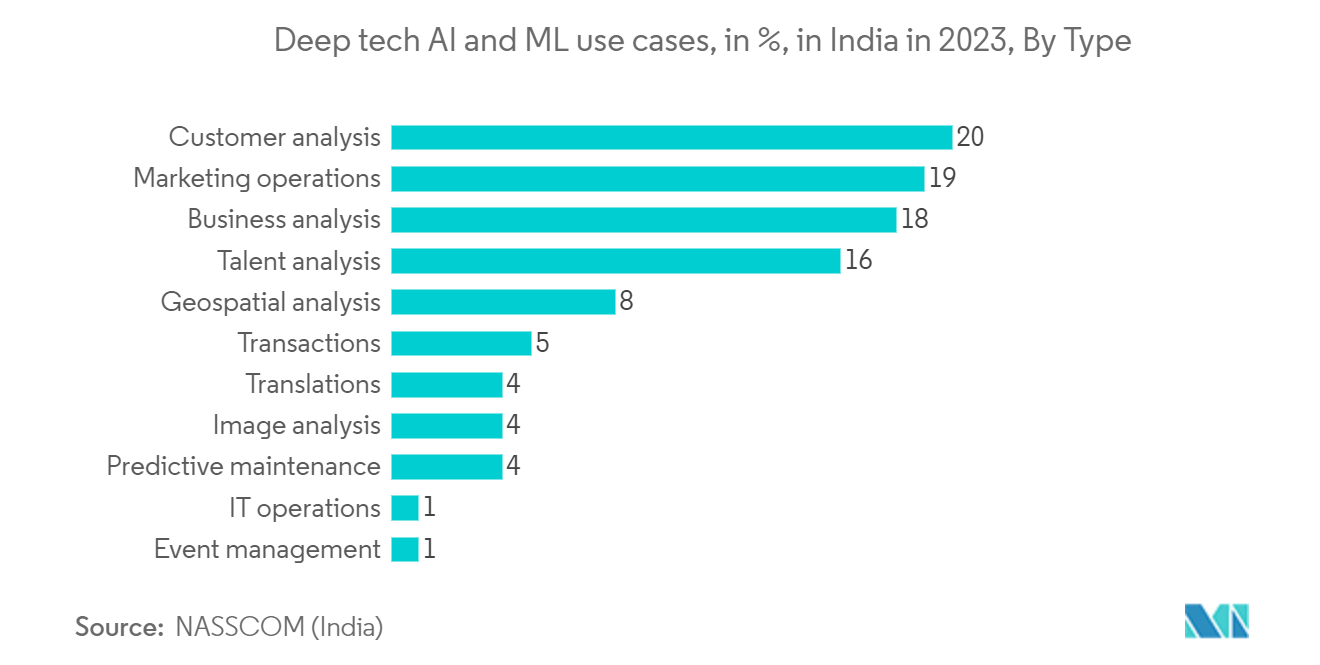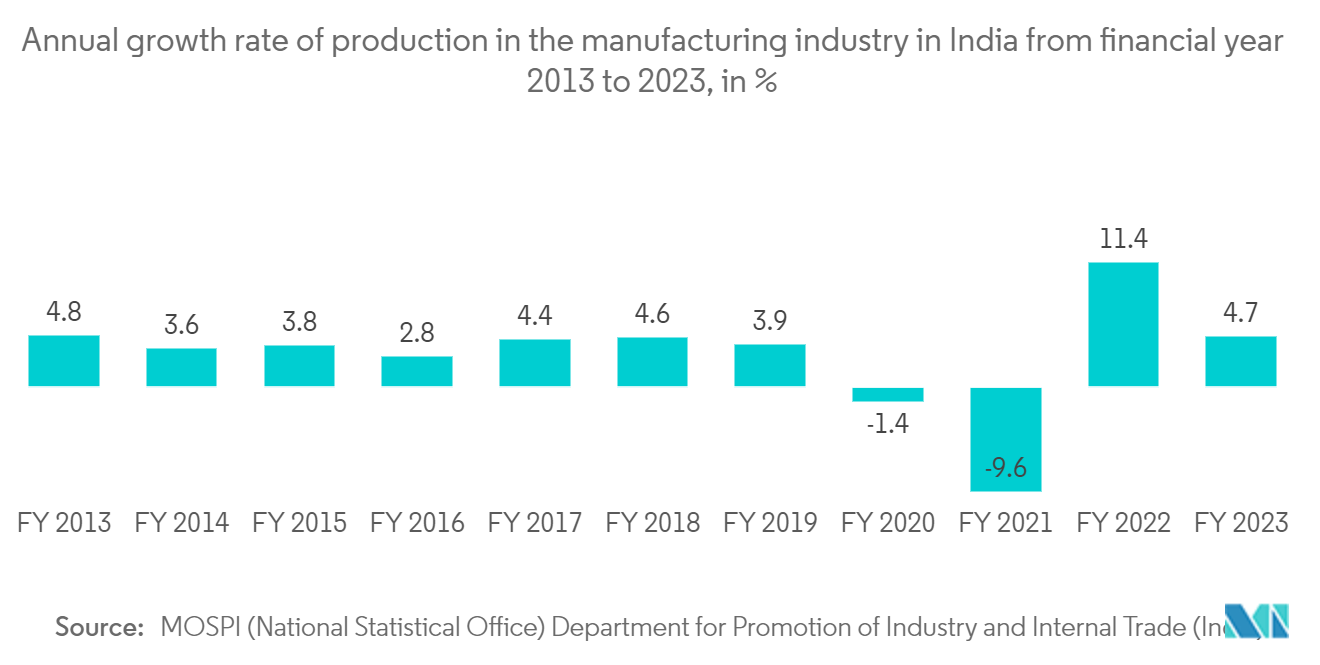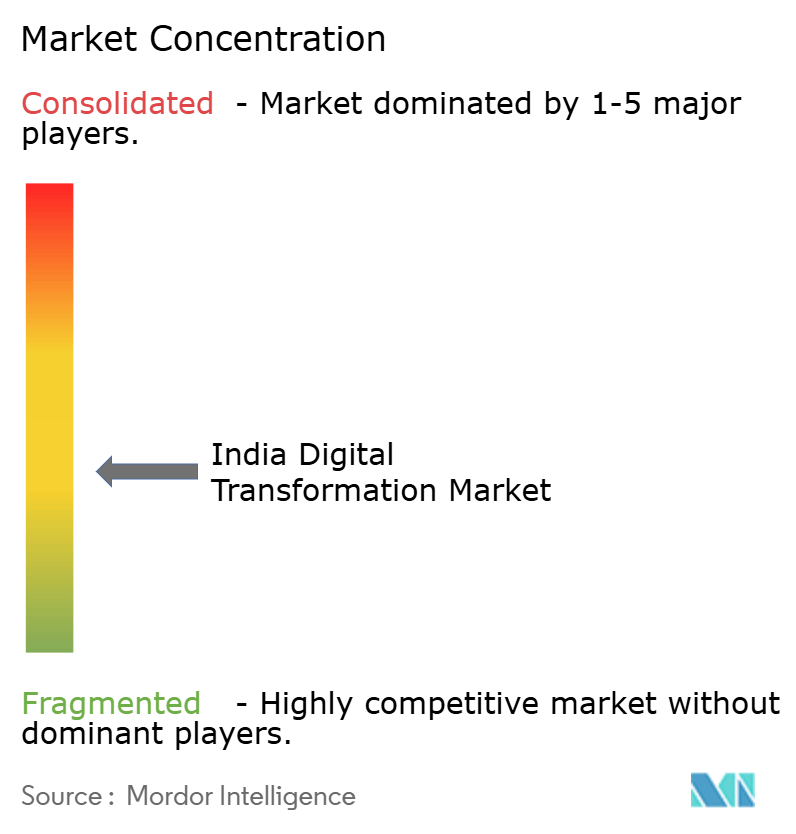India Digital Transformation Market Analysis
The India Digital Transformation Market size is estimated at USD 108.42 billion in 2025, and is expected to reach USD 276.95 billion by 2030, at a CAGR of 20.63% during the forecast period (2025-2030).
- Several factors, including increased investments, advancements in automation technology, a thriving E-commerce sector, and a rising demand for warehousing technologies like dark stores and micro-fulfillment centers, were poised to drive significant growth in India's digital transformation market. For instance, in February 2023, Prozo, a 'full-stack' supply chain company, introduced the Mini-Load Automated Storage and Retrieval System (mini-load ASRS). This move not only marked a significant technological leap for the company, making it the first 3PL company in India to integrate such advanced automation into its supply chain, but also brought it closer to achieving 100% warehouse automation.
- Moreover, as per IBEF, a surge in internet and smartphone usage has fueled most of the industry's expansion. The number of smartphone users in India is projected to reach 887.4 million by 2030.
- The adoption of packaged food is anticipated to drive the studied segment for the market. According to the Retailers Association of India, the market value of packaged food in India is estimated to increase from INR 4, 240 billion in 2022 to INR 5.798 billion in 2025.
- Government initiatives, like Digital India, and favorable FDI policies are instrumental in introducing new online modes of commerce, facilitating the growth of e-commerce in the country. Further, the proposition of the "National E-commerce Policy," which consolidates a lawful agenda regarding the data flow and the involvement of foreign government agencies, is expected to strengthen the e-commerce landscape in the country. Moreover, the Foreign Direct Investment policy has permitted 100% FDI in the e-commerce marketplace model under the automatic route.
- To support the digital transformation in India, several companies are launching innovative products. For instance, in February 2023, ABB launched its latest ABB Ability Symphony Plus distributed control system release to cater to the power generation and water industries. It delivers customers access to digital solutions like fleet asset management enabled by ABB Ability Genix Asset Performance Management. It also allows customers to access process and alarm data from mobile devices through the ABB Mobile Operations application, facilitating them to stay updated to react faster, save costs, and reduce downtime.
- However, developing economies like India have been representative of labor-intensive formats. With labor costs significantly low compared to other developed countries, high investment in industrial automation systems with additional staff training has restrained the adoption of automation systems, especially in the SMEs. The availability of cheap labor is likely to function as a restraining factor for the growth of the studied market during the forecast period.
India Digital Transformation Market Trends
Industrial Robotics is Expected to Occupy the Largest Market Share
- The industrial robotics segment consists of SCARA robots, articulated robots, cartesian robots, piece picking robots, collaborative industry robots (cobots), parallel robots, etc. The adoption of industrial robots is proliferating in most end-users and applications as these robots enhance speed, flexibility, accuracy, reduced product damage, and the efficiency of operations.
- In manufacturing industries, industrial robots are generally used for the fabrication, finishing, transfer, and assembly of parts. In material handling industries, where finished products are prepared for distribution, these robots are used for picking, sorting, packaging, and palletizing of products.
- In a country such as India, where there is a significant trend for startups and entrepreneurship, robotics and automation can play an important role in the growth of the country. Additionally, the Indian government has been promoting the use of automation and robotics through different initiatives such as the ‘Make in India’ campaign and the National Robotics Initiative.
- The use of collaborative robots (cobots) is rapidly increasing as they are utilizing advanced software, sensors, and end-of-arm tooling that safely and quickly respond to the changes in the environment and assist in improving efficiency.
- The collaborative robots in the market are also becoming more affordable, easier to use, and less simple for training purposes. This primarily offers multiple options to organizations, which increases the drive and the demand for these robots.
Manufacturing is Expected to be the Fastest Growing Market
- Manufacturing already contributes significantly to the Indian economy, making over 17% of its GDP and employing over 27 million people. As government incentives, business tax cuts, and infrastructure spending encourage capital investment in manufacturing, India is also in a position to become the global manufacturing hub. Therefore, the increasing emphasis on increasing process efficiency and lowering the cost of production across multiple industrial verticals are expected to drive the market in the future.
- According to the Ministry of Statistics and Programme implementation, manufacturing production in India increased 5.7% year-over-year in May 2023, picking up speed from a growth of 4.9% in the previous month and above market estimates of 1.8%. This growth was attributed to the contributions of several business sectors. Due to market demand being driven by technological advancements, force/torque sensors, and end-effectors, manufacturers are heavily automating these processes with robotics.
- The overall ecosystem has improved rapidly and has also become affordable for manufacturers to implement innovative solutions and is expected to drive demand and adoption among the supply chain partners of big manufacturers. With the growth of the Indian manufacturing sector, additional competitive advantages in productivity, profitability, safety, and long-term manufacturing processes have become necessary. Due to the 'Make in India' push and the easing of FDI policies in the manufacturing sector across several industries, the notion of semi-knock-down production and domestic manufacture is projected to grow.
- According to the 8th annual "State of Smart Manufacturing Report" by Rockwell Automation, India has the most manufacturing companies that invest in technology. India's manufacturers are spending more on technology than the typical manufacturer worldwide (23%), spending 35% of their operating budgets on it. The survey also reveals that smart manufacturing is becoming a more major driver of digital transformation for Indian firms, which is anticipated to result in a considerable increase in demand for the market digital transformation in India.
- IBEF predicts that the Indian e-commerce market will increase from USD 38.5 billion in 2017 to USD 200 billion by 2026. It is anticipated that among Indian consumers with access to the internet, there will be a considerable demand for foreign goods and brands, which would lead to a significant increase in the need for highly automated warehouses to manage the rising number of packages entering the country. The need for automation solutions is anticipated to remain strong in the upcoming years due to increasing investments in expanding warehousing capabilities.
- Moreover, India's industrial automation market will grow in the future with rapid development in Artificial Intelligence (AI) and Robotics Technology (RT); automation is revolutionizing the modern world, as robots can perform a slew of functions without considerable human intervention. AI and RT are expected to double in India in the next 3 to 5 years, and every organization must be ready to embrace the change. Innovative solution for demanding automation tasks and complex robot applications implemented is increasing, which will also help the market grow.
- Conclusively, considering the immense growth of the various end-user industries and the subsequent increasing adoption of automation solutions at various levels will propel the growth of the market over the next five years.
India Digital Transformation Industry Overview
India's Digital Transformation Market is semi fragmented due to the presence of numerous players in the country, including Accenture PLC, Google LLC (Alphabet Inc.), Siemens AG, IBM Corporation, and Microsoft Corporation, mid-sized firms, small enterprises, and start-ups. Players in the market are adopting strategies such as partnerships, mergers, innovations, and acquisitions to enhance their product offerings and gain sustainable competitive advantage.
- May 2024: Universal Robots, a Danish leader in manufacturing smaller, flexible industrial cobots, unveiled 'Collaborate INDIA,' India's flagship cobot conference. Set for June 4, 2024, at The Westin Pune Koregaon Park, this event was set to define the trajectory of collaborative automation in India. In the realm of artificial intelligence (AI), Universal Robots' collaborations with industry giants like NVIDIA, Solomon, and Mech-Mind played a pivotal role in infusing advanced AI capabilities into cobots. This strategic alliance not only bolstered the cobots' functionalities but also broadened their applications, thus reshaping the automation landscape. Attendees of the conference could anticipate insightful dialogues on the intersection of AI and robotics, shedding light on their transformative impact on the manufacturing sector.
- May 2024: India Accelerator introduced a new vertical, RUMS (Robotics, Unmanned & Space), with the goal of nurturing innovation and advancement in the robotics and unmanned sector. The focus had been on extending strategic backing to startups specializing in Unmanned Aerial Systems (UAS), Counterdrone Systems, Ground Robots, and Space ventures. In its early stages, the accelerator had planned to invest a capital of 10-15 million USD in promising early-stage startups within this domain, facilitated by its partner, Finvolve.
India Digital Transformation Market Leaders
-
Tata Consultancy Services
-
Infosys
-
Wipro
-
Tech Mahindra
-
Accenture
- *Disclaimer: Major Players sorted in no particular order
India Digital Transformation Market News
- May 2024: The Ministry of Electronics and Information Technology (MeitY) inaugurated the first National Additive Manufacturing Symposium (NAMS) 2024, marking a significant step in India’s push towards advanced manufacturing technologies. MeitY Secretary S Krishnan inaugurated the event, which featured the release of an Additive Manufacturing Landscape Report and unveiled an indigenously developed additive manufacturing machine. The symposium aimed to provide an overview of India’s Additive Manufacturing (AM) ecosystem.
- February 2024: The Indian Institute of Technology Madras (IIT-M) launched an Additive Manufacturing lab equipped with over 25 FabMachines 3D Printers from Fabheads Automation. This move positioned the IIT Madras lab as a central hub for additive manufacturing innovation and education. By incorporating FabMachines technology, the institute aimed to provide students with practical exposure and deeper insights into advanced manufacturing techniques.
India Digital Transformation Industry Segmentation
Digital transformation is the process of incorporating digital technologies such as artificial intelligence and machine learning, extended reality (VR & AR) for industrial applications, IoT, industrial robotics, blockchain, digital twins, 3D printing/ additive manufacturing, industrial cyber security, wireless connectivity, edge computing, smart mobility, and others across various end-user industries.
India digital transformation market is segmented by type (analytics, artificial intelligence, and machine learning extended reality (XR), IoT, industrial robotics, blockchain, additive manufacturing/3D printing, cybersecurity, cloud and edge, computing, and others (digital twin, mobility, and connectivity), by end-users (manufacturing, oil, gas, and utilities, retail & e-commerce, transportation, and logistics, healthcare, BFSI, telecom, and IT, government and public sector, Others (education, media & entertainment, environment, etc). The market sizes and forecasts are provided in terms of value in USD for all the above segments.
| By Type | Analytics, Artificial Intelligence and Machine Learning | Current Market Scenario and Market Projections for the Forecast | Period | |
| Key Growth Influencers (Drivers, Challenges, and Opportunities) | ||||
| Use Case Analysis | ||||
| Market Outlook | ||||
| Extended Reality (XR) | Current Market Scenario and Market Projections for the Forecast | Period | ||
| Key Growth Influencers (Drivers, Challenges, and Opportunities) | ||||
| Use Case Analysis | ||||
| Market Outlook | ||||
| IoT | Current Market Scenario and Market Projections for the Forecast | Period | ||
| Key Growth Influencers (Drivers, Challenges, and Opportunities) | ||||
| Use Case Analysis | ||||
| Market Outlook | ||||
| Industrial Robotics | Current Market Scenario and Market Projections for the Forecast | Period | ||
| Key Growth Influencers (Drivers, Challenges, and Opportunities) | ||||
| Use Case Analysis | ||||
| Market Outlook | ||||
| Blockchain | Current Market Scenario and Market Projections for the Forecast | Period | ||
| Key Growth Influencers (Drivers, Challenges, and Opportunities) | ||||
| Market Outlook | ||||
| Additive Manufacturing/3D Printing | Current Market Scenario and Market Projections for the Forecast | Period | ||
| Key Growth Influencers (Drivers, Challenges, and Opportunities) | ||||
| Use Case Analysis | ||||
| Market Outlook | ||||
| Cybersecurity | Current Market Scenario and Market Projections for the Forecast Period | |||
| Key Growth Influencers (Drivers, Challenges, and Opportunities) | ||||
| Use Case Analysis | ||||
| Market Outlook | ||||
| Cloud and Edge Computing | Current Market Scenario and Market Projections for the Forecast Period | |||
| Key Growth Influencers (Drivers, Challenges, and Opportunities) | ||||
| Use Case Analysis | ||||
| Market Outlook | ||||
| Others (digital twin, mobility and connectivity) | Current Market Scenario and Market Projections for the Forecast Period | |||
| Key Growth Influencers (Drivers, Challenges, and Opportunities) | ||||
| Market Breakdown by Type (Digital Twin, Mobility and Connectivity) | ||||
| Use Case Analysis | ||||
| Market Outlook | ||||
| By End-User Industry | Manufacturing | Oil, Gas and Utilities | ||
| Retail & e-commerce | ||||
| Transportation and Logistics | ||||
| Healthcare | ||||
| BFSI | ||||
| Telecom and IT | ||||
| Government and Public Sector | ||||
| Others (Education, Media & Entertainment, Environment Etc) | ||||
India Digital Transformation Market Research Faqs
How big is the India Digital Transformation Market?
The India Digital Transformation Market size is expected to reach USD 108.42 billion in 2025 and grow at a CAGR of 20.63% to reach USD 276.95 billion by 2030.
What is the current India Digital Transformation Market size?
In 2025, the India Digital Transformation Market size is expected to reach USD 108.42 billion.
Who are the key players in India Digital Transformation Market?
Tata Consultancy Services, Infosys, Wipro, Tech Mahindra and Accenture are the major companies operating in the India Digital Transformation Market.
What years does this India Digital Transformation Market cover, and what was the market size in 2024?
In 2024, the India Digital Transformation Market size was estimated at USD 86.05 billion. The report covers the India Digital Transformation Market historical market size for years: 2019, 2020, 2021, 2022, 2023 and 2024. The report also forecasts the India Digital Transformation Market size for years: 2025, 2026, 2027, 2028, 2029 and 2030.
India Digital Transformation Industry Report
Statistics for the 2025 India Digital Transformation market share, size and revenue growth rate, created by Mordor Intelligence™ Industry Reports. India Digital Transformation analysis includes a market forecast outlook for 2025 to 2030 and historical overview. Get a sample of this industry analysis as a free report PDF download.

